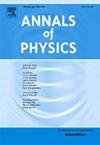Bulk viscous matter with decaying vacuum energy density: A model for late-time evolution of the Universe
IF 3
3区 物理与天体物理
Q2 PHYSICS, MULTIDISCIPLINARY
引用次数: 0
Abstract
In this study, we combine viscous dark matter and running vacuum energy density in a single cosmological setting and investigate their cosmological implications. Specifically, we consider a well-studied form of running vacuum energy density model inspired by -gravity or, equivalently from the Brans–Dicke scalar-tensor theory that arises from a covariant action, i.e., and a recently proposed general parameterization for bulk viscosity , where and are constants. In this setup, we derived analytical solutions for the Hubble parameter and the scale factor of the universe within the framework of Eckart’s theory of bulk viscosity. The viability of the proposed model equation is tested by constraining its free model parameters using the Hubble parameter and type Ia supernovae (SNe Ia) observations at different redshifts, and the goodness-of-fit of the model to the data was also checked by a function minimization. Various significant cosmological parameters were estimated and analytically explained in the evolution dynamics of the universe, and a comparison of our proposed model with the CDM model was studied. The application of dynamical systems analysis reveals the physical aspects of the new phase space that emerge from the model and derives stability conditions that ensure complete cosmological dynamics. The model is consistent with the local and generalized second laws of thermodynamics at the apparent horizon throughout the evolution of the universe.
具有真空能量密度衰减的大块粘性物质:宇宙晚时间演化的一个模型
在这项研究中,我们将粘性暗物质和运行真空能量密度结合在一个单一的宇宙学环境中,并研究它们的宇宙学意义。具体来说,我们考虑了一种得到充分研究的运行真空能量密度模型形式,该模型受到f(R)-重力的启发,或者同样来自于由协变作用产生的Brans-Dicke标量张量理论,即ρΛ=läa+λ(ȧa)2+12ηρm,以及最近提出的体粘度的一般参数化ζ=ζ0+ζ1ȧa+ζ2äȧ,其中l,λ,η,ζ0,ζ1和ζ2是常数。在这种情况下,我们在Eckart的体积粘度理论框架内推导出了哈勃参数和宇宙尺度因子的解析解。利用哈勃参数H(z)和Ia型超新星(SNe Ia)在不同红移下的观测数据,通过约束其自由模型参数来检验模型方程的可行性,并通过χ2函数最小化检验模型与数据的拟合优度。对宇宙演化动力学中各种重要的宇宙学参数进行了估计和解析解释,并与ΛCDM模型进行了比较。动力系统分析的应用揭示了从模型中出现的新相空间的物理方面,并推导出确保完整宇宙动力学的稳定性条件。该模型在整个宇宙演化的视界上符合局部和广义热力学第二定律。
本文章由计算机程序翻译,如有差异,请以英文原文为准。
求助全文
约1分钟内获得全文
求助全文
来源期刊

Annals of Physics
物理-物理:综合
CiteScore
5.30
自引率
3.30%
发文量
211
审稿时长
47 days
期刊介绍:
Annals of Physics presents original work in all areas of basic theoretic physics research. Ideas are developed and fully explored, and thorough treatment is given to first principles and ultimate applications. Annals of Physics emphasizes clarity and intelligibility in the articles it publishes, thus making them as accessible as possible. Readers familiar with recent developments in the field are provided with sufficient detail and background to follow the arguments and understand their significance.
The Editors of the journal cover all fields of theoretical physics. Articles published in the journal are typically longer than 20 pages.
 求助内容:
求助内容: 应助结果提醒方式:
应助结果提醒方式:


